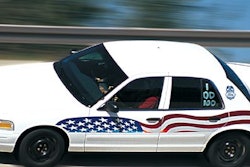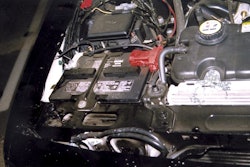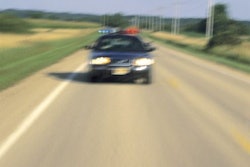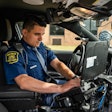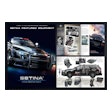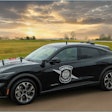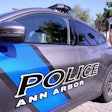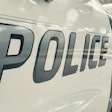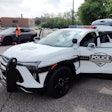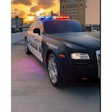Each year more law enforcement officers die in the line of duty from traffic accidents than from any other cause. So it would stand to reason that police vehicle training and high-performance driving instruction would be among the most hazardous of all police training.
But it's not. Very few officers ever fall victim to traffic accidents in vehicle training programs.
There are a variety of reasons why police vehicle training has an enviable safety record. One, most serious police vehicle accidents in the field are caused by other motorists, particularly drunks smashing into the rear of stopped patrol cars. And two, police vehicle training programs have been designed to minimize risk.
Lt. David W. Halliday has directed the Michigan State Police's precision driving program since 1995, and he says one of the big differences between his school and the street is the quality of equipment. "We use new vehicles with the most up-to-date technology instead of police cars that are four, five, or six years old with maybe 100,000 to 400,000 miles on them," he explains.
Safety guidelines are drilled into students from day one at the Michigan State Police (MSP) program, which trains officers throughout Michigan, from other states, and from foreign countries. In addition to familiarizing students with the rules of the range from the get-go, the instructors at the MSP program require their charges to wear crash helmets in all maneuvers except slow speed exercises. Also, any car used in high-performance training at the MSP program must be equipped with roll cages and five-point harness systems.
Doing It on the Cheap
The MSP precision driving program benefits from a Cadillac course. The Lansing-based facility includes such luxuries as a control tower for directing traffic. And the training includes student reactions to such hazards as simulated civilian cars driven by MSP instructors, wet pavement, and even simulated black ice.
But Halliday says agencies can easily execute a safe vehicle training program even if they don't have the resources of the MSP. All it takes is imagination, improvisation, and attention to detail.
For example, instead of using a control tower like the one at the MSP facility to regulate traffic, trainers can easily improvise a cheaper solution. "All you have to do is have someone in charge of the range who is overseeing everything from a separate car," Halliday says. "You don't have to have a tower; you can control everything with a radio."
Under Pressured
As for attention to detail, Halliday says one of the best ways to enhance range safety is through careful maintenance of the vehicles. Two critical areas of concern are the wheels and tires on the vehicles used in the training. "Our lug nut specifications go anywhere from 40 pounds to 140 pounds of torque," he says. "We check that every day."
Another detail that never escapes attention at the MSP range is tire pressure. Halliday believes tire pressure is the single biggest factor in ensuring the safety of his range cars. "Patrol car tires are supposed to be 35 PSI cold. If you have less than that or you have more than that, then your car won't handle properly in an emergency," he explains. "When you have your tires properly inflated, you maximize the contact patch of the tire, which allows you to stop quicker and in shorter distance."[PAGEBREAK]
Donorcycles
Besides the staff's attention to maintenance and safety rules, another protection that students have at the MSP range is a 3,000-pound metal cocoon that keeps them from spilling onto the pavement. Officers in motorcycle programs are not so fortunate.
There's a reason why emergency room personnel call two-wheelers "donorcycles;" motorcycle accident victims are usually young, reckless men with healthy organs and massive head injuries. But despite the bad reputation of motorcycles, their record in police work is much less bloody than it is in public transportation. Further, even though many officers entering motorcycle training programs are novice riders to the point that some have only a few days experience on "bikes," the safety record of police motorcycle training is impressive.
Officer Mike Cardoza is one of the motorcycle instructors at the California Highway Patrol academy in Sacramento, and he says injuries are infrequent and minor among his students. "We have some bumps and bruises every few classes," he says. "Accidents don't happen as often as you might think."
Cardoza attributes the CHP training unit's safety record to a number of factors. Classes are small, limited to no more than 15 students, and there are three instructors per class. Also, students are required to wear helmets and many students wear their ballistic vests while riding to protect against blunt force injuries. Further, instructors preride all routes looking for road surface hazards before the students hit the course.
Similar safety precautions are in practice at other motorcycle training programs. "We preride every area before we have the students ride through it," says Sgt. Timothy Curtis of the Los Angeles County Sheriff's Department motorcycle training detail. "Also, we take an extraordinary amount of time explaining what would be considered some of the more hazardous types of patterns such as the deceleration exercise and the cone weave exercise."
Both the LASD and CHP programs have another built-in safety feature. Students in both courses progress gradually through a series of increasingly more complex exercises. "We start off with the simplest of procedures," says Curtis. "If we have students who are doing really well, then we will advance them through the course. If we have students who are having trouble, we will spend more time with them, remediate them, or give them one-on-one training."
Perhaps the greatest safety precaution any vehicle trainer can take is to not let the student attempt maneuvers beyond his or her skill level. "For the beginning student, we want to see them learn the basics of how to ride the motorcycle before they take on more challenges," says Curtis.
MSP's Halliday agrees and adds, "We don't let students drive at 100 percent of their ability. Even on the streets, you should always drive at 80 percent of your ability. That's a philosophy that we teach here. If you're driving at 100 percent of your ability and you make an error, then there's no chance of recovery."






